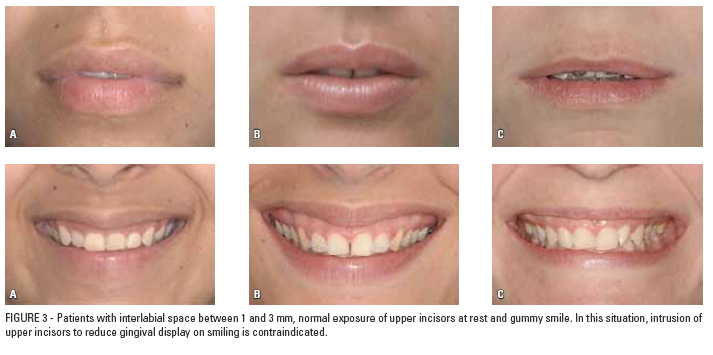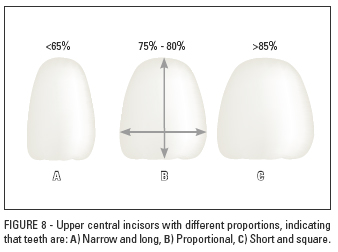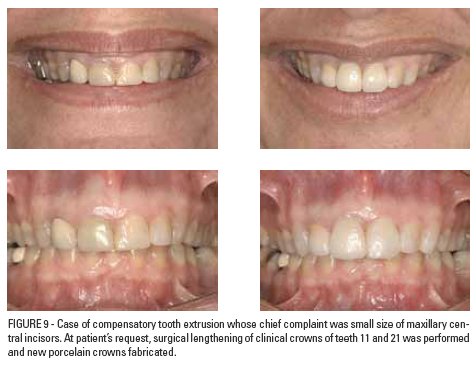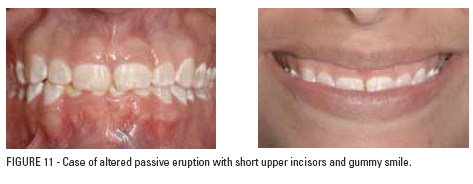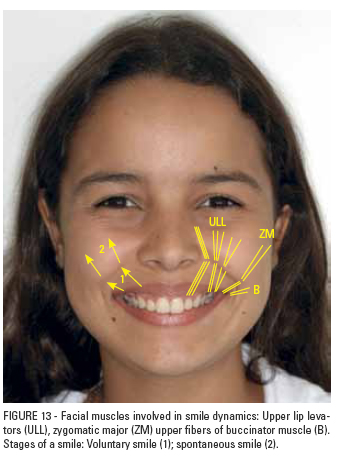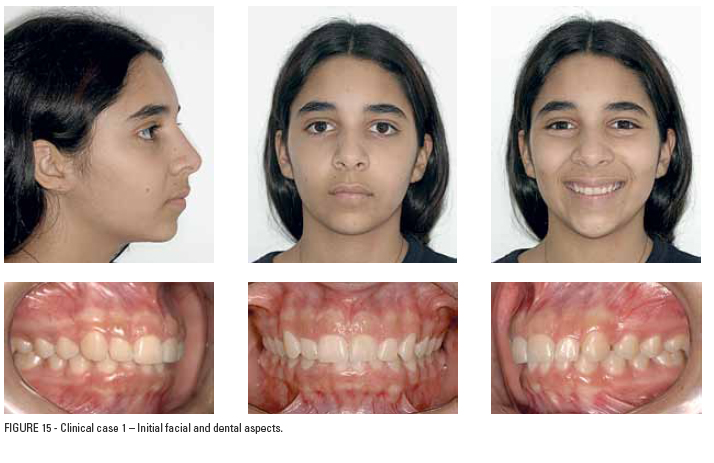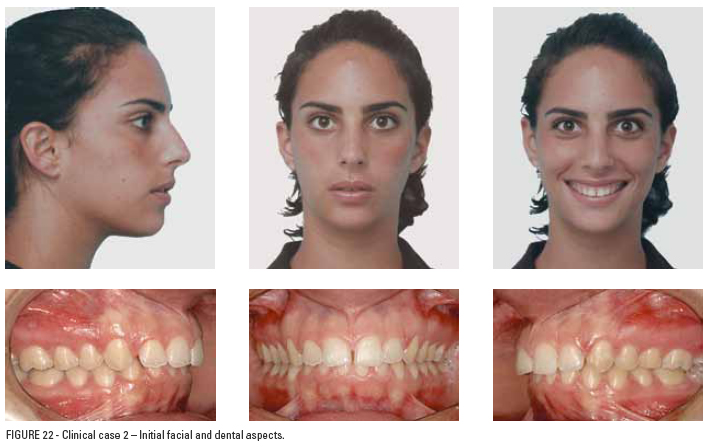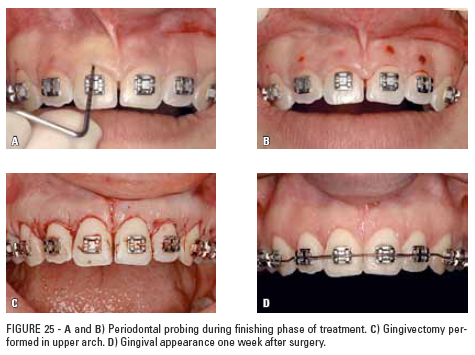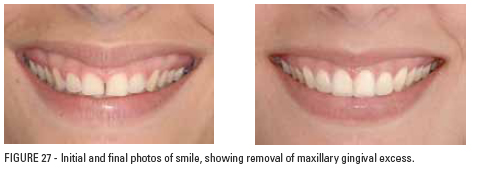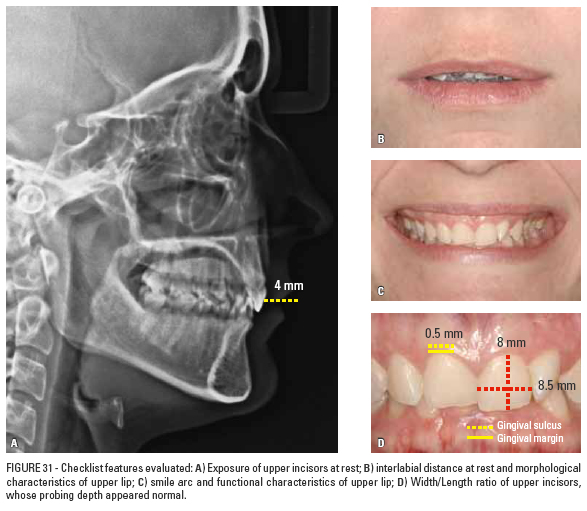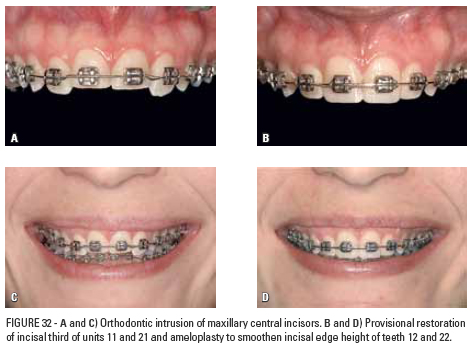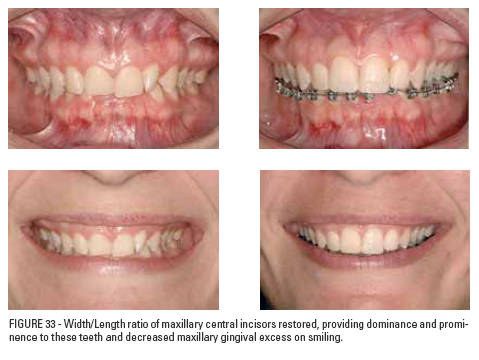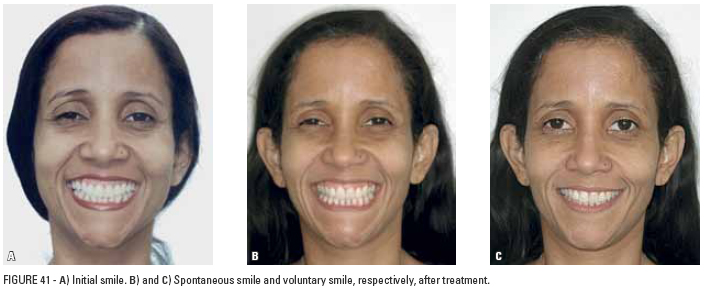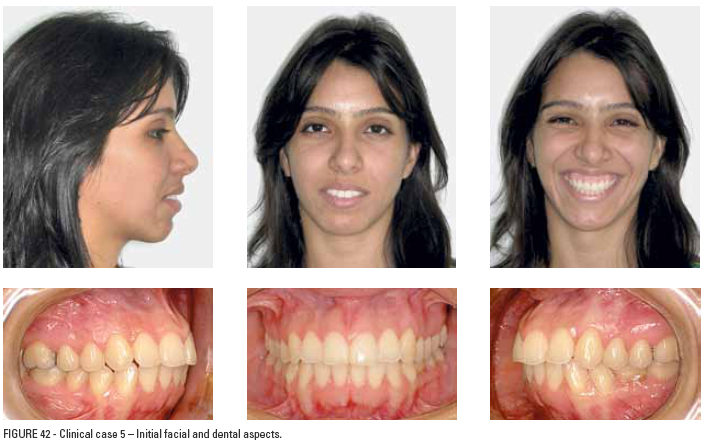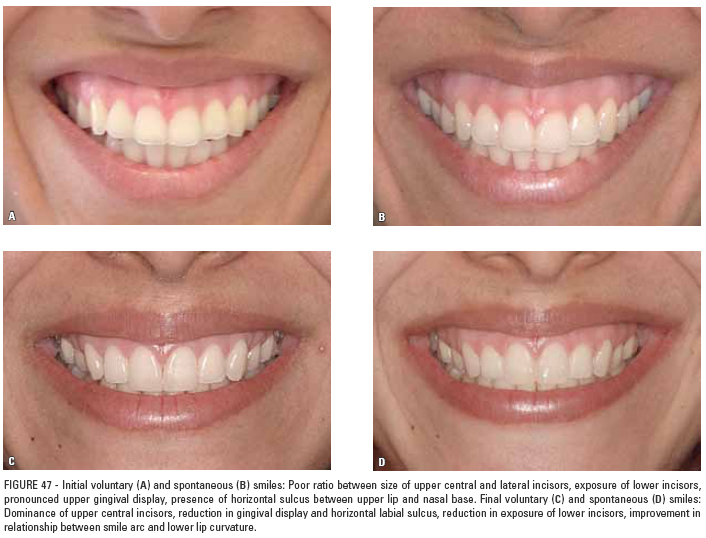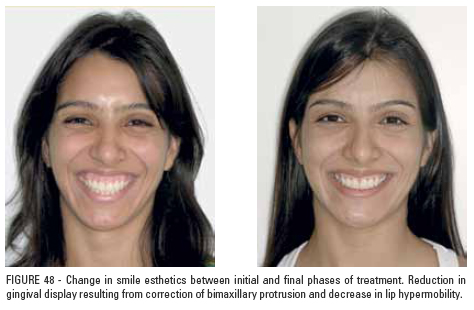Abstracts
INTRODUCTION: Excessive gingival display on smiling is one of the problems that negatively affect smile aesthetics and is, in most cases, related to several etiologic factors that act in concert. A systematic evaluation of some aspects of the smile and the position of the lips at rest can facilitate the correct assessment of these patients. OBJECTIVE: To present a checklist of dentolabial features and illustrate how the use of this record-keeping method during orthodontic diagnosis can streamline decision making in treating the gummy smile, which usually requires knowledge of orthodontics and other medical and dental specialties.
Orthodontics; Aesthetics; Smile
INTRODUÇÃO: a exposição exagerada da gengiva ao sorrir é um dos problemas que afetam negativamente a estética do sorriso e, na maioria das vezes, está relacionada à atuação conjunta de alguns fatores etiológicos. A análise sistematizada de alguns aspectos do sorriso e da posição de repouso dos lábios facilita a correta avaliação desses pacientes. OBJETIVO: apresentar um checklist de características dentolabiais e ilustrar como esse método de registro de dados, durante o diagnóstico ortodôntico, pode facilitar a tomada de decisões no tratamento do sorriso gengival, que geralmente envolve o conhecimento da Ortodontia e de outras especialidades médico-odontológicas.
Ortodontia; Estética; Sorriso
SPECIAL ARTICLE
Checklist of esthetic features to consider in diagnosing and treating excessive gingival display (gummy smile)
Máyra Reis SeixasI; Roberto Amarante Costa-PintoII; Telma Martins de AraújoIII
IMSc in Orthodontics, Rio de Janeiro Federal University (UFRJ). Collaborating Faculty Member, Specialization Program in Orthodontics, Bahia Federal University (UFBA). Diplomate of the Brazilian Board of Orthodontics and Facial Orthopedics
IIMSc in Orthodontics, Rio de Janeiro Federal University (UFRJ). Professor of Orthodontics (EBMSP). Collaborating Faculty Member, Specialization Program in Orthodontics, Bahia Federal University (UFBA)
IIIMSc and PhD in Orthodontics, Rio de Janeiro Federal University (UFRJ). Head Professor and Coordinator, Prof. José Édimo Soares Martins Center of Orthodontics (UFBA). President, Brazilian Board of Orthodontics and Facial Orthopedics
Contact address
ABSTRACT
INTRODUCTION: Excessive gingival display on smiling is one of the problems that negatively affect smile esthetics and is, in most cases, related to several etiologic factors that act in concert. A systematic evaluation of some aspects of the smile and the position of the lips at rest can facilitate the correct assessment of these patients.
OBJECTIVE: To present a checklist of dentolabial features and illustrate how the use of this record-keeping method during orthodontic diagnosis can help decision making in treating the gummy smile, which usually requires knowledge of orthodontics and other medical and dental specialties.
Keywords: Orthodontics. Esthetics. Smile.
INTRODUCTION
Whenever patients are able to clearly view their own gummy smile (GS) this condition becomes an important esthetic complaint during orthodontic anamnesis. Although it appears fairly frequently in private offices, very few studies in the literature address GS, its diagnosis and treatment as a central topic. Treating the smile is a challenging task for orthodontists. One historical reason for this fact is that in the 20th century, particularly in the 1950s and 1960s, orthodontic diagnosis and treatment were based on cephalometry and, therefore, esthetic concepts were defined primarily based on a profile view of the patient. Nevertheless, in their orthodontic records orthodontists continued to focus on the use of plaster models, which provide but a static record of occlusion, neglecting the dynamic analysis of speech and smile, as well as the evaluation of morphological and functional characteristics of the lips. Since the act of smiling is a dynamic process, the beauty of a smile depends not only on correct dental and skeletal positioning, but also on the anatomy and function of the lip muscles, over which orthodontists must recognize that they exercise little or no control.
GUMMY SMILE (GS)
Most dental professionals believe that during smiling the upper lip should position itself at the gingival margin of the maxillary central incisors.1,2,3 However, it is known that displaying a certain amount of gingiva is esthetically acceptable and in many cases imparts a youthful appearance.4,5,6
Although there are several parameters in the literature that define GS (amount in millimeters of gingival display on smiling), what seems most likely to arouse orthodontists' interest are the beliefs held by the general public concerning what is, or is not esthetically acceptable. Research conducted by Kokich Jr et al7 found that a smile is considered unestheticby both clinicians and lay peoplewhen gingival exposure reaches 4 mm. For orthodontists, who tend to be more demanding, 2 mm gingival exposure on smiling is enough to compromise smile harmony (Fig 1).
Smile height is influenced by sex and age. There is evidence that women display higher smiles than men8,9 and that dentogingival exposure decreases with age.8 This information has clinical relevance since GS self-corrects to a certain extent over time, especially in men.10
Its etiology is related to several factors, such as: Vertical maxillary excess, upper dentoalveolar protrusion, extrusion and/or altered passive eruption of anterosuperior teeth and hyperactivity of upper lip levator muscles. In most cases, however, some or all of these factors are correlated. Orthodontists seem to be the professionals most qualified to critically assess the weight of each of these factors, among which hyperactivity of the upper lip levator muscles is the least studied and hitherto understood.
DIAGNOSIS
Despite the etiologic factors involved in the gummy smile, some issues should be necessarily considered during clinical evaluation. Systematic recording of (a) interlabial distance at rest, (b) exposure of upper incisors during rest and speech, (c) smile arc, (d) width/length ratio of maxillary incisors and (e) morphofunctional characteristics of the upper lip by means of a checklist (Fig 2). All these records can be very useful in the diagnostic stage. By including these data in the orthodontic consultation file one ensures that information key to the treatment plan are not forgotten or overlooked.
1. Interlabial distance at rest
When entering this information, it is crucial that orthodontists include in the initial orthodontic records a photograph showing the patient's lips at rest. Phonetic assessments based on video footage can also prove useful.
There is no direct relationship between GS and amount of interlabial space at rest.11 Contrary to a long-standing belief, patients with normal upper lip length and reduced interlabial space can present with excessive gingival display on smiling. When interlabial space at rest is normal (1-3 mm), GS is considered to have a predominantly muscular origin (Figs 3 A, B and C). Usually, the main cause of increased interlabial space is dentoskeletal disharmony (vertical maxillary excess and/or protrusion of upper incisors), which may or may not be associated with anatomical and/or functional changes in the upper lip (Figs 4 A, B and C).11,13 Diagnosing GS's muscular etiology is crucial for immediately recognizing the limitations of orthodontic treatment and seeking help from other specialties such as, for example, esthetic medicine. Moreover, a correct diagnosis can decrease the risk that GS correction may interfere with other favorable esthetic features of the smile. This fact lends support to the paradigm of contemporary orthodontics, which consists in identifying the positive esthetic features of the smile to ensure that such features are not affected by treatment of dentofacial problems.14
2. Upper incisor exposure during rest and speech
It is known that when the lips are at rest the amount of exposure of the upper incisors is approximately 2 to 4.5 mm in women and 1 to 3 mm in men (Fig 5). This characteristic is directly related to the youthful appearance of the smile and it is expected to decline throughout life (given the lengthening of the upper lip that results from the process of tissue maturation and aging).10,11,12
To keep a record of this condition, one can use a standard lateral cephalometric radiograph of the lips at rest and measure the distance in millimeters between the incisal edge of the maxillary central incisor and the lower contour of the upper lip (Fig 6). Phonetic assessments during clinical examination are also important. Patients should be instructed to articulate phrases formed by phonemes that induce greater incisor exposure8 such as the following sentence (in Brazilian Portuguese): "Tia Ema torce pelo time do Corinthians," followed by a broad, spontaneous smile, as exemplified at www.dentalpress.com.br/journal.
The following factors are related to increased exposure of the upper incisors at rest: Upper incisor extrusion, dolichocephalic facial pattern, vertical maxillary excess and a short upper lip. When treatment planning involves maxillary impaction and/or intrusion of anterosuperior teeth, the magnitude of dentoskeletal change should not be based on the amount of gingival display one wishes to decrease, but rather on the degree of incisor exposure (at rest) that one wishes to maintain. Patients whose esthetics can benefit from upper incisor intrusion do not usually pose a significant challenge to the orthodontic or surgical planning of GS correction (Figs 3 A, B and C). On the other hand, patients who exhibit adequate incisor exposure during rest and speech require more careful planning (Figs 4 A, B and C).11,14
3. Smile arc
The term smile arc is defined as the curvature formed by the incisal edges of anterosuperior teeth. To be considered an esthetic and youthful smile, this curvature must be parallel to the superior margin of the lower lip (Fig 7A).15 Women's smiles feature a sharper curvature, whilst in men the curvature appears more flat. In individuals with brachycephalic facial pattern, the smile arc is flatter than in meso- and dolichocephalic individuals.11
In some patients with GS maxillary incisor intrusion can be performed. However, failure to assess the smile arc can result in inappropriate flattening of its curvature, rendering it less attractive.16,17
4. Width/length ratio of maxillary incisors
Cosmetic dentistry provides pertinent information regarding tooth proportions and morphology. According to some authors, it is of paramount importance that smile proportions conform to the face.17,18,19 The ratio known as "gold standard" determines that the width of the maxillary incisors should be approximately 80% of its length (Fig 8), with acceptable variations between 65% and 85%, whereas for upper lateral incisors that same ratio should be around 70%.17,18,19
A high width/length ratio (W/L) is often found in squared teeth, while lower ratios are associated with a more elongated appearance. Prosthetic dentistry concepts determine that the proportions and morphology of upper central incisor crowns should be in harmony with the patient's facial pattern.12,18,19
In subjects with GS, it is important to assess whether the crowns of anterior teeth appear very short. If this is the case, the next step is to establish the reason for such shortness, which may occur primarily for two reasons:
A) Reduction in height of the incisal edges of upper teeth by friction and/or fracture
In these cases, as incisors extrude so do their periodontal attachment and support. This process, called "compensatory tooth extrusion,"20 may be responsible for excessive gingival display during smile. On periodontal probing, these teeth show normal gingival sulcus depth, and treatment can be accomplished through periodontal surgery with prosthetic rehabilitation, or orthodontics associated with restorative dentistry.
Clinical crown lengthening surgery with osteotomy
In view of the fact that this procedure induces exposure of the root surface and requires additional restorative treatment, it should be thoroughly discussed with the patient (Fig 9). Moreover, due to the tapering of tooth roots, prosthetic crowns will tend to acquire a more triangular shape, making it hard to achieve satisfactory interproximal esthetics. The emergence of "black spaces" after surgery is not uncommon. The advantage of this approach includes shorter treatment time and no need for fixed orthodontic appliances. On the downside, there is a decrease in crown/root ratio, loss of bone support and need for prosthetic restoration of the teeth involved.12,18,19,20
Orthodontic intrusion and subsequent restoration of tooth proportions using restorative dentistry procedures (Fig 10).17
B) Gingival overgrowth
The etiologic factors behind gingival overgrowth are diverse, ranging from tissue hypertrophy due to infection and/or medication, to altered passive eruption.20,21 The process of tooth eruption is deemed completed when teeth reach the occlusal plane and go into function. The soft tissues follow this trend and ultimately the gingival margin migrates apically almost as far as the cementoenamel junction (CEJ). This whole process is called passive eruption. When, for reasons hitherto unknown, the gingiva fails to migrate to its expected position, this condition is named altered passive eruption. If, on periodontal probing, these teeth exhibit increased values of gingival sulcus depth, such situation constitutes a clear indication that the patient should be referred to a periodontist to treat his/her gummy smile (Fig 11).20,21 Normally, the lengthening of incisor crowns is accomplished by removing excess gingival tissue overlying the cervical enamel. When the distance between alveolar bone crest and CEJ is less than 1 mm (insufficient for adaptation of connective tissue attachment), osteotomy is necessary to establish accurate biological distances.21
5. Morphofunctional characteristics of the upper lip
The lips play a pivotal role in facial expression, especially in the act of smiling, whose variations are related to the morphofunctional features of the lip, such as: Length, thickness and insertion, direction and contraction of various lip-related muscle fibers.22
As regards length, the average value for men's upper lip is 24 mm and for women, 20 mm.23 It may seem that individuals with a short upper lip display more gingiva when smiling, but lip length is probably not directly related to a gummy smile.11 Severe vertical maxillary excess cases, for example, may have an upper lip of normal size or even quite long, which complicates GS correction, as lip length allows little or no incisor intrusion whatsoever.11,14
To assess upper lip length one needs to measure the height of the philtrum and labial commissures. Philtrum height is reflected in the distance between the subnasale (Sn) and Stomion (St) points of the upper lip. In turn, commissure height is obtained by measuring perpendicularly the distance between these structures (C1 and C2) and their projections (C1'and C2') in a horizontal line that joins the two wing bases (Fig 12).
The linear values of these measures are not as important as the relationship between the length of the philtrum and commissures. In children and adolescents, philtrum height is slightly lower than commissure height and this difference can be explained by differential maturation of the lips during growth. Normally, when this happens in adults it causes increased exposure of the incisors during rest and speech (Fig 12B).14
Thin lips are also known to exhibit greater strain and responsiveness both to dentoalveolar changes and to the contractile pattern of the muscles.9,23
Upper lip mobility, which results from the action of specific muscles, seems to be the main feature to consider in evaluating the soft tissues involved in smiling.24-28 In addition to the muscle that surrounds the lips internally (orbicularis oris), several other muscle groups influence upper lip movement, i.e.: Levator muscle of upper lip, levator muscle of upper lip and nose wing, levator muscle of the corner of the mouth, zygomatic major, zygomatic minor, depressor of the nasal septum (Fig 13).11
Smile takes shape in two stages: In the first (voluntary smile) the upper lip is elevated towards the nasolabial sulcus by contraction of the levator muscles, which originate from this sulcus and are inserted into the lips. The medial bundles elevate the lip in the region of the anterior teeth, and the lateral bundles in the region of the posterior teeth until they meet with resistance from the adipose tissue in the cheeks. The second stage (spontaneous smile) starts with a higher elevation of both the lips and the nasolabial sulcus through the agency of three muscle groups: The upper lip levator, which originates from the infraorbital region, the zygomatic major muscle and the superior fibers of the buccinator muscle (Fig 13).11,22
According to the classification of Rubin,22 there are three types of smile: (a) The so-called "Mona Lisa" smile, whereby the labial commissures are displaced upwards through the action of the zygomatic major muscle; (b) the "canine smile," when the upper lip is elevated in uniform fashion; and finally (c) the "complex smile," when the upper lip behaves like the "canine smile" and the lower lip moves inferiorly exposing the lower incisors.
Studies show that the upper lip muscles of individuals with GS are considerably more efficient than those with a normal level of gingival display.11,24-28
In GS patients with normal facial proportions, lip length within average limits, marginal gingiva located near the CEJ and normal width-length ratio, etiology may be associated with hyperactivity of the muscles that move the upper lip during smile. A non-hyperactive lip moves approximately 6 mm to 8 mm from a resting position to a broad smile. On the other hand, a hyperactive upper lip moves a distance 1.5 to 2 times greater (Fig 14).23 For these cases, some cosmetic procedures are available which have been studied in patients with facial paralysis since 1973.27 Among these, silicone implantation at the bottom of the vestibule at the base of the anterior nasal spine, infiltration of botulinum A toxin and resective procedures in the muscles responsible for upper lip mobility produce satisfactory esthetic results.24-27
Cost-effectiveness, considering the durability, safety and low morbidity of these procedures, must be analyzed by orthodontists before this approach is safely and more often suggested to patients.
USING THE CHECKLIST
Clinical Case 1
The patient, a 13-year-old girl, reported as chief complaint the reduced size of her maxillary incisors and presented with the following characteristics: Facial thirds with balanced proportions, slightly convex profile, mild mandibular retrusion, competent lip seal, moderate GS, Angle Class I malocclusion with slight extrusion of upper incisors and excessive overbite (Fig 15).
Checklist assessment (Fig 16) revealed interlabial space, exposure of upper incisors at rest and normal morphofunctional upper lip, as well as appropriate smile arc curvature. A low width/length ratio of maxillary incisors was the only feature assessed as unfavorable. (Fig 17). Initial periodontal probing of these teeth showed increased values of gingival sulcus depth, suggesting a state of altered passive eruption.
Orthodontic treatment was performed without extraction and, after further probing during the finishing phase, gingivectomy was indicated across the entire anterosuperior region (Fig 18). This procedure achieved a better width/length ratio of maxillary incisors and reduced gingival display (Figs 19 and 20). The patient's smile benefited from increased aesthetics and improved dental proportions, preserving incisor exposure at rest and a pleasant smile arc curvature (Figs 20 and 21).
Clinical Case 2
The patient, an 18-year-old girl, reported as chief complaint the reduced size of her maxillary incisors and excessive maxillary gingival display, presenting with the following characteristics: Facial thirds with balanced proportions, straight profile, GS, Angle Class I malocclusion with extrusion of maxillary incisors and excessive overbite (Fig 22).
Checklist assessment (Fig 23) revealed normal interlabial space and upper incisor exposure at rest as well as pleasant looking smile arc. The low width/length ratio of maxillary incisors and hypermobility of the upper lip on smiling were regarded as negative features (Fig 24).
Initial periodontal probing showed increased values of gingival sulcus depth, suggesting a state of altered passive eruption associated with upper lip hypermobility. These two factors contributed substantially to increased gingival exposure in the anterior and posterior regions of the smile.
Corrective orthodontic treatment was performed without extractions. In the final phase, after further periodontal probing, gingivectomy was performed to eliminate gingival pseudopockets present throughout the anterosuperior region (Fig 25). Composite restorations on the incisal edges of teeth 12, 11, 21 and 22 helped smoothen the incisal profile, which combined with an adequate width/length ratio of maxillary incisors to improve smile esthetics (Fig 26). Despite a certain degree of gingival display still present due to hypermobility of the upper lip, the esthetic outcome of the treatment was rated as satisfactory by the patient (Figs 27 and 28).
Clinical Case 3
The patient, a 21-year-old woman, reported as chief complaint dental crowding and excessive upper gingival display, and exhibited the following characteristics: Facial thirds with balanced proportions, slightly concave profile, competent lip seal, GS, Angle Class I malocclusion, excessive overbite, extrusion and lingual inclination of maxillary central incisors (Fig 29).
Checklist assessment (Fig 30) revealed normal interlabial space and pleasant smile arc. Normal exposure of the upper central incisors at rest, low length/width ratio of these teeth and upper lip hypermobility were considered as unfavorable features. Initial periodontal probing disclosed normal gingival sulcus depth. Incisal edge wear of maxillary central incisors was observed, which led to a diagnosis of compensatory tooth extrusion (Fig 31).
Total corrective orthodontic treatment was performed without extractions, with intrusion and correction of upper central incisor lingual inclination. After leveling the upper arch, the incisal edges of teeth 12 and 22 were smoothened through ameloplasty and units 11 and 21 were restored temporarily with composite (Fig 32). This approach improved the width/length ratio and preserved upper incisor exposure at rest. Some small gingival exposure still remained due to lip hypermobility but not enough to compromise final smile esthetics (Figs 33 and 34).
Clinical Case 4
The patient, a 36-year-old woman, reported as chief complaint the presence of spaces in the first premolar region and showed the following characteristics: Facial thirds with balanced proportions, slightly convex profile, adequate lip seal, GS, Angle Class I malocclusion, residual spaces resulting from first premolar extractions, extruded and lingually inclined upper incisors and excessive overbite (Fig 35).
Checklist assessment (Fig 36) revealed: Interlabial space and increased exposure of upper incisors at rest, pleasant smile arc (with pronounced curvature) and a short and thin upper lip with hypermobility. Upper incisor length/width ratio was satisfactory (Fig 37).
Dental alignment and leveling, correction of axial inclination of the incisors, canines and second premolars and space closure with retraction of anterior teeth were performed during orthodontic treatment (Figs 38 and 39, and Table 1). Although part of the checklist points to the possibility of intrusion of the upper teeth, any attempt to correct excessive gingival display by this means could cause undesirable flattening of the smile arc. Therefore, leveling of upper teeth demanded special care. The morphofunctional characteristics of the upper lipthin, short and with hypermobilityproduced a complex smile and posed a major obstacle to the orthodontic treatment of excessive gingival display.
The upper incisal silhouette was restored through cosmetic dental remodeling. Ameloplasty of the incisal edges of teeth 12 and 22 was performed and, additionally, composite was provisionally added to the incisal edges of teeth 11 and 21.
Despite improved smile esthetics in terms of dental position, gingival display was virtually maintained to ensure that the orthodontic approach would be consistent with the contemporary treatment paradigm (Figs 40 and 41).
Clinical Case 5
The patient, a 25-year-old woman, reported as chief complaint dentoalveolar bimaxillary protrusion and incompetent lip seal, and exhibited the following characteristics: Increased lower face, convex profile, incompetent lip seal, GS, Angle Class I malocclusion and pronounced dentoalveolar bimaxillary protrusion (Fig 42).
Checklist assessment (Fig 43) revealed significant changes in some features: There were significantly increased interlabial space and upper incisor exposure at rest, a short upper lip with hypermobility, flat smile arc and adequate width/length ratio of maxillary central incisors, although there was disparity between the size of the central and lateral incisors (Fig 44).
The upper alveolar protrusionpresent in Angle Class II, Division 1 malocclusions, and Angle Class I bimaxillary protrusionmay be related to the gummy smile, a fact long reported in the literature.29 The alveolar "plateau" formed by the maxillary incisors was overly inclined labially, which seemed to cause the muscle of the upper lip to stretch further, pulling the upper lip upward and backward, as it settles in the deepest region of the alveolar process (Fig 46A).
Since the correction of maxillary protrusion often reduces excessive gingival display on smiling, this issue should always be addressed when planning GS treatment.29,30
Although this is a classic case of vertical maxillary excess with an indication for surgery the patient rejected this option. The only other option would be to reduce gingival display through orthodontic treatment by reducing the bimaxillary protrusion and the anterosuperior dentoalveolar "plateau." Total corrective treatment was performed with extraction of teeth 14, 24, 75 and 44, incisor retraction and maximum vertical control (Figs 45 and 46, and Table 2).
Correction of bimaxillary protrusion benefited facial esthetics (Fig 45), improved lip competence (Figs 45 and 46) and decreased apical displacement of the upper lip during smile (Fig 47B). A closer view reveals some major changes: Behavior change of upper lip muscles on smiling (evidenced by the elimination of the horizontal sulcus formed between the upper lip and nose base), and improved relationship between the smile arc and the lower lip (afforded by the fact that the latter was repositioned superiorly and posteriorly) (Fig 47).
With the purpose of improving the leveling of the anterosuperior gingival contour teeth 11 and 21 were intruded and their incisal edges enlarged with composite. To further establish a proportional relationship between upper central and lateral incisors, teeth 12 and 22 underwent interproximal stripping and cosmetic remodeling by rounding of the distolabial angle.
The amount of gingival display still present after treatment completion did not affect the degree of patient satisfaction in terms of dentofacial benefits (Fig 48).
FINAL CONSIDERATIONS
Excessive gingival display on smiling is considered a cosmetic issue that often leads patients to seek orthodontic treatment. Addressing this problem can prove challenging as it involves a wide range of etiological factors which, in most cases, work in concert. To evaluate these cases, orthodontists should analyze the patient's static and dynamic smile, as well as their speech and lip position at rest. In this analysis it is mandatory that the following factors be observed: (a) Interlabial distance, (b) exposure of upper incisors during rest and speech, (c) smile arc, (d) width/length ratio of maxillary central incisors and (e) morphofunctional characteristics of the upper lip. The checklist advanced in this article can assist in GS diagnosing and planning and may lead to the GS correction within the scope of today's orthodontic treatment paradigm.
ACKNOWLEDGEMENTS
The authors wish to thank Drs. Edmália Barreto (periodontics), Eutímio Torres (prosthodontist), Maria Cândida Teixeira and Alessandra Mattos (restorative dentistry), for their contribution to the clinical cases presented in this study.
References
- 1. Legan HL, Burstone CJ. Soft tissue cephalometric analysis for orthognatic surgery. J Oral Surg. 1980 Oct;38(10):744-51.
- 2. Levine RA, McGuire M. The diagnosis and treatment of the gummy smile. Compend Contin Educ Dent. 1997Aug;18(8):757-62,64.
- 3. Marckley RJ. An evaluation of smiles before and after orthodontic treatment. Angle Orthod. 1993 Fall;63(3):183-9.
- 4. Arnett GW, Bergman RT. Facial keys to orthodontic diagnosis and treatment planning. Part I. Am J Orthod Dentofacial Orthop. 1993 Apr;103(4):299-312.
- 5. Fowler P. Orthodontics and orthognatic surgery in the combined treatment of an excessive gummy smile. New Zealand Dent J. 1999 Jun;95:53-4.
- 6. Zachrisson BU. Esthetic factors involved in anterior tooth display and smile: vertical dimension. J Clin Orthod. 1998;32(7):432-45.
- 7. Kokich VO Jr, Kiyak HA, Shapiro PA. Comparing the perception of dentists and lay people to altered dental esthetics. J Esthet Dent. 1999;11(6):311-24.
- 8. Cosendey VL. Avaliação do relacionamento entre o lábio superior e incisivos durante a fala e o sorriso [dissertação]. Rio de Janeiro (RJ): Universidade do Estado do Rio de Janeiro; 2008.
- 9. Vig RG, Brundo GC. Kinetics of anterior tooth display. J Prosthet Dent. 1978 May;39(5):502-4.
- 10. Desai S, Upadhyay M, Nanda R. Dynamic smile analysis: changes with age. Am J Orthod Dentofacial Orthop. 2009; Sep 3(136):310.e1-10.
- 11. Peck S, Peck L, Kataja M. The gingival smile line. Angle Orthod. 1992;2(62):91-100.
- 12. Cohen M. Interdisciplinary treatment planning: principles, design, implementation. 1st ed. Seattle: Quintessence; 2008.
- 13. Pascotto RC, Moreira M. Integração da Odontologia com a Medicina Estética: correção do sorriso gengival. RGO. 2005 jul-set;53(3):171-5.
- 14. Sarver DM, Ackerman MB. Dynamic smile visualization and quantification: Part 1. Evolution of the concept and dynamic records for smile capture. Am J Orthod Dentofacial Orthop. 2003;124(1):4-12.
- 15. Sarver DM. The importance of incisor positioning in the esthetic smile: The smile arc. Am J Orthod Dentofacial Orthop. 2001 Aug;2(120):98-111.
- 16. Frush JO, Fisher RD. The dysesthetic interpretation of the dentogenic concept. J Prosthet Dent. 1958;8:558.
- 17. Sarver DM. Principles of cosmetic dentistry in orthodontics: Part 1. Shape and proportionality of anterior teeth. Am J Orthod Dentofacial Orthop. 2004;Dec 6(126):749-53.
- 18. Levin EL. Dental esthetics and golden proportion. J Prosthet Dent. 1978 Sep;40(3):244-52.
- 19. Kokich VG, Nappen DL, Shapiro PA. Gingival contour and clinical crown length: their effect on the esthetic appearance of maxillary anterior teeth. Am J Orthod. 1984 Aug;86(2):89-94.
- 20. Borghetti A. Cirurgia plástica periodontal. 1ª ed. Porto Alegre: Artmed; 2002.
- 21. Garber DA, Salama MA. The aesthetic smile: diagnosis and treatment. Periodontology 2000. 1996 Jun;11(1):18-28.
- 22. Rubin LR. The anatomy of a smile: its importance in the treatment of facial paralysis. Plast Reconstr Surg. 1974 Apr;53(4):384-7.
- 23. Burstone CJ. Lip posture and its significance in treatment planning. Am J Orthod. 1967 Apr;53(4):262-84.
- 24. Simon Z, Rosenblatt A, Dorfman W. Eliminating a gummy smile with surgical lip repositioning. J Cosmetic Dentistry. 2007 Spring;1(23):100-8.
- 25. Pessoa TJL, Freitas RS, Lida AC, Beck PT. Liberação do músculo depressor do septo nasal para tratamento do sorriso gengival. Rev ImplantNews. 2010;7(6):777-83.
- 26. Polo M. Botulinum toxin type A in the treatment of excessive gingival display. Am J Orthod Dentofacial Orthop. 2008 Feb;133(2):195-203.
- 27. Rubinstein A, Kostianovsky A. Cosmetic surgery for the mal-formation of the laugh: original technique. Prensa Med Argent. 1973;60:952-4.
- 28. Rubin LR, Mishriki Y, Lee G. Anatomy of the nasolabial fold: the keystone of the smiling mechanism. Plast Reconstr Surg. 1989 Jan;83(1):1-10.
- 29. Jacobs JD. Vertical lip changes from maxillary incisor retraction. Am J Orthod. 1978 Oct;74(4):396-404.
- 30. Bilodeau JE, Lane JA. Dilemmas in treating a patient with severe bialveolar protrusion and a hyperdynamic lip. Am J Orthod Dentofacial Orthop. 2007 Oct;132(4):540-9.
Endereço para correspondência
Publication Dates
-
Publication in this collection
18 July 2011 -
Date of issue
Apr 2011
History
-
Accepted
Mar 2011 -
Received
Dec 2010




